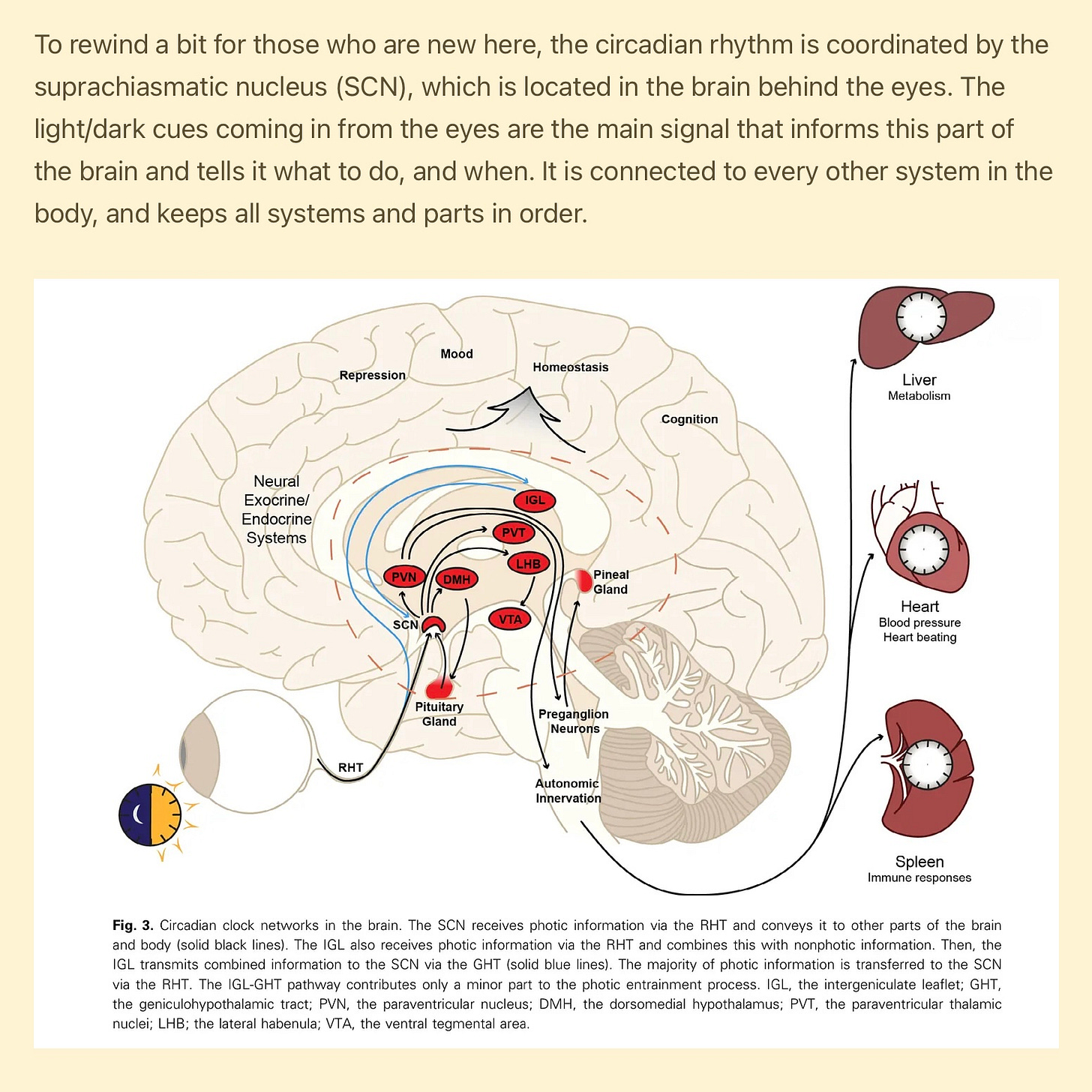How your body reacts to longer nights 🌙
The magic of 14 hours of darkness ✨
Whew! This last moon was wild here in the Northern Hemisphere. Have you noticed the moon is actually higher in the sky than it was this Summer?
As the Earth tilts toward Winter, the sun appears lower in the sky, but the moon actually gets higher!
Depending on where you live, this seasonal variance between the sun and moon can be as much as 47 degrees.
This variance may be part of why in Norse traditions, the moon was seen as a masculine timekeeper, more dependably marking the days, than the more transient and feminine sun.
In polar climates, fickle sunlight disappears for months at a time.
With the sun so low in the sky, this leaves the moon as the primary celestial body lighting the sky.

I’m really feeling the chill of Autumn, here at Halloween, and along with the brighter moons, have been enjoying:
gleaning the orchard for the last apples
watching as each long night brings out more yellows, golds and reds in the trees the next morning
helping the children string madrone berry garlands for this year’s holiday decorations
and the first fires in the wood stove
There are many things to enjoy about the changing season.
This time of year also means making certain lifestyle adjustments so I can better support my family’s circadian health.
Where we live, nights are now approaching 14 hours: a very significant circadian light threshold I felt excited to share about with you in this post.
What’s magical about a 14 hour night?
A 14 hour night is very special. A 14 hour night lasts approximately from 6 pm to 8 am.
That’s a long time to spend in the dark!
Check out the graphic below (▫️white is wakefulness and ◾️black is sleep—and the rectangles marked with L show the length of daylight available).
Thomas Wehr originally discovered this in his sleep lab, where he was able to induce different patterns of sleep on animals as well as humans by manipulating the light environment:
The practical knowledge here is if you live in a temperate or polar climate and you don’t supplement with artificial blue light, you may just find yourself in a polyphasic sleep pattern this Winter!
I’ve actually known many people who start wearing blue blockers and being more mindful of their light environments express quite a bit of dismay because they didn’t expect for sleep to break into shorter segments in the Winter.
When you are used to consolidated sleep as the normal, it can feel like you have backslid or done something wrong if you find yourself wakeful and restless for hours under the brightness of the winter moon and don’t recognize it for the natural sleep pattern it can be.
*Side note: Circadian polyphasic sleep is not the same thing as waking anxious and freaked out in the middle of the night or at 4 am because you haven’t been eating well or in a good pattern lately and your metabolism is now going haywire.
So, for those who have work schedules that don’t allow flexibility for spending 14 hours in nighttime activities, you might need to carefully supplement with light in the evenings to prevent this effect.
But if you do have the flexibility—and especially if you are a parent—you may find some wonderful, secret time for joy, self-care, contemplation and even companionship with your spouse if you do allow your family to “go full Circadian.”
What does circadian polyphasic sleep feel like in everyday life?
Circadian polyphasic sleep in the seasons of long nights
sleep for around 4 hours after sunset
wake up for a couple of hours in the middle of the night (especially when aided by a bright, overhead winter moon)
go back to sleep for another 4 hours until dawn
In the Summer, the pattern of circadian polyphasic sleep is very different.
Circadian polyphasic sleep in the seasons of long days
In the summer when nights are very short and you don’t manipulate your light environment with blackout curtains and artificial light, you’ll tend to:
sleep for around 4 hours around midnight
take a second sleep around noon
This can also feel disorienting, especially if you sleep longer overnight and then have super lethargy midday but haven’t scheduled time for at least a little siesta.
Other circadian consolidated and unconsolidated sleep patterns
Some other patterns of sleep we could talk about are:
“Normal” sleep, which is 8 hours of consolidated sleep, and is what happens with 16 hours of light and what people tend to give themselves with unfettered access to artificial light
2 hours of sleep spread evenly around the quarters of the day, which is what tends to happen to people on bedrest in a dimly lit environment
Sleep and darkness therapy
What I find very interesting about the winter sleep pattern, is 14 hours of darkness is the initial therapeutic dose for manic episodes.
There have been multiple studies showing successful improvements in rapid cycling bipolar disorder by enforcing 14 hours of darkness overnight1.
However, in the research studies, the found participants unwilling to keep up the 14 hour darkness routine. After a few nights, they would reduce the time in darkness to 10 hours.
Ten hours of darkness is another important threshold, because it takes about 2 hours for pineal melatonin to start flowing in darkness. This means 10 hours of darkness allows for about 8 hours of melatonin release.
Nowadays, blue light blocking glasses tend to be used for mental health therapies because they allow more normal activity than pure darkness (while still allowing melatonin to flow and circadian rhythms to prepare for sleep at night).
In the circadian health community, I’ve noticed many prefer to use blue light blocking glasses and to maintain a more normal sleep schedule, too.
The relationship of light to mania
In situations of a mental health crisis, stabilizing the nighttime light environment is important, followed by increasing morning light to further improve sleep.
It’s very important for anyone with mental health conditions to stabilize their nighttime light environment before increasing sunlight or bright light exposure.
Sudden changes in bright light exposure can actually trigger manic episodes in bipolar and schizophrenia.
This helps explain why manic episodes tend to be lower in the fall and winter, and higher in spring when day length is increasing. I wrote more about this here:
Manic season
Spring’s arrival brings with it sweet relief from Winter’s cold darkness. It’s a time of year we all long for and celebrate! However, there’s a difficult aspect to the return of the sunlight. Our ancestors knew this, hence the many stories of the harshness of the Sun’s energy. For example, the legends of the Greek god Apollo characterize the Sun’s dual nature, with his powers of both inflicting and healing disease. The Sun is a force with both generative and destructive powers.
I find all this helpful to understand, because even without a psychological diagnosis, we all experience these seasonal pulls on our energy.
Getting in more of a circadian lifestyle may even increase your sensitivity to light and the intensity with which you feel the season’s changes.
The two ends of the long night
With regard to the long night, there are three points where it can be challenging and you have to strategize a little for the sake of your family’s circadian health.
There’s the early sunset, pushing dinner hour earlier. With less UV available in the day, this compresses the eating window and changes our gut microbiome2 and metabolism3. I shared more about this shift through the lens of the shift from solar-derived Vitamin D to dietary and stored Vitamin D last week:
Then, at this time of year, there’s the middle of the night wakings—or, in the scientific way of speaking, the polyphasic pattern of sleep where it is in chunks less than 8 hours. I find babies and young children don’t seem to be extra wakeful in the middle of the long nights, but puberty’s changes to sleep make older ones more susceptible to sleeplessness during these times just like we adults are. Using candlelight or circadian-friendly nightlights can protect the all-important melatonin and autophagy (“self-eating”) processes even for those who are wakeful between first and second winter sleep.

And finally, there’s the waiting for sunrise as you wake around dawn, but the sun is long behind you. Depending on where you live, even if you “sleep in” during these darker seasons, you may still be waiting for the sun in the morning. For example, I slept in until 7 am this morning, and it was still pretty much dark outside. When this is me, I use my circadian night lights indoors, I still go outside and look at the brightest part of the sky, and I try to eat something rich in fat and protein while I start breakfast for the family since they usually sleep in later than me.
Circadian polyphasic sleep summary:
Well, as is often the case, I put too many topics in this post, but I hope you still enjoyed it and found some value. Liking the posts helps with discovery, as it does when you share! Thank you for reading and being a part of the growing community of light-savvy people and light gurus.
What I wanted you to know is if you “go full Circadian” and are eating seasonally and continuing to spend time outdoors (as the saying goes, there is no bad weather, only bad clothing), and carefully blocking blue light between dusk and dawn, you may find yourself falling into a polyphasic pattern of sleep depending on your latitude.
Updates:
You can still get a Heart Centered Planner from Danielle LaPorte before the holidays and use my code NIKKOLOVE10 for 10% off, a special bonus, and worldwide expedited shipping for just US$9! This planner is what I will be using for 2025 (though, to be honest, I did choose the undated version because I know it may take me longer than a year to make it through all the reflections).
LIFE HACKING IS NOT LIVING. A lot of planner systems give you more anxiety. All the tracking of the doing. We need planning systems that help you plan from within.
Danielle LaPorte, creator of the Heart Centered Planner
I added several new videos to the paid subscriber video archive this month. Here’s where you can watch them.
Harvey, A. G., Talbot, L. S., & Gershon, A. (2009). Sleep Disturbance in Bipolar Disorder Across the Lifespan. Clinical psychology : a publication of the Division of Clinical Psychology of the American Psychological Association, 16(2), 256–277. https://doi.org/10.1111/j.1468-2850.2009.01164.x
Conteville, L. C., & Vicente, A. C. P. (2020). Skin exposure to sunlight: a factor modulating the human gut microbiome composition. Gut microbes, 11(5), 1135–1138. https://doi.org/10.1080/19490976.2020.1745044
Ishihara, A., Courville, A. B., & Chen, K. Y. (2023). The Complex Effects of Light on Metabolism in Humans. Nutrients, 15(6), 1391. https://doi.org/10.3390/nu15061391








Fascinating read, thank you for sharing it! The relation of light to mental health was particularly interesting to me. Years ago, when I was in the throes of a deep mental health crisis, I managed to pull myself out of it intuitively by changing up my sleep habits and screen time. Now I know how it worked!
Really good article. I’m glad I found you👍